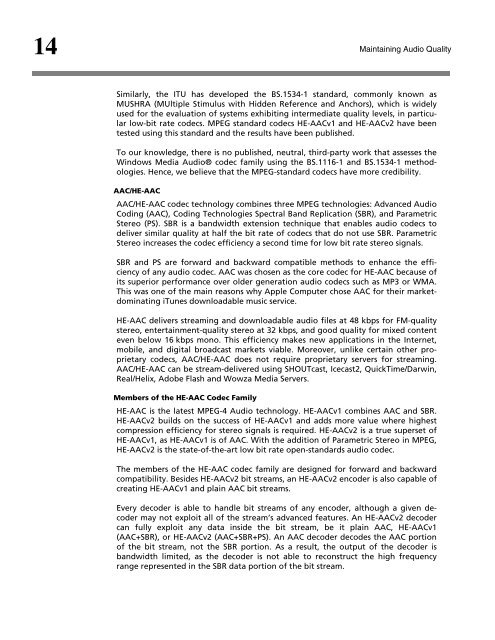Maintaining Audio Quality in the Broadcast Facility 2011 - Orban
Maintaining Audio Quality in the Broadcast Facility 2011 - Orban
Maintaining Audio Quality in the Broadcast Facility 2011 - Orban
Create successful ePaper yourself
Turn your PDF publications into a flip-book with our unique Google optimized e-Paper software.
14<br />
<strong>Ma<strong>in</strong>ta<strong>in</strong><strong>in</strong>g</strong> <strong>Audio</strong> <strong>Quality</strong><br />
Similarly, <strong>the</strong> ITU has developed <strong>the</strong> BS.1534-1 standard, commonly known as<br />
MUSHRA (MUltiple Stimulus with Hidden Reference and Anchors), which is widely<br />
used for <strong>the</strong> evaluation of systems exhibit<strong>in</strong>g <strong>in</strong>termediate quality levels, <strong>in</strong> particular<br />
low-bit rate codecs. MPEG standard codecs HE-AACv1 and HE-AACv2 have been<br />
tested us<strong>in</strong>g this standard and <strong>the</strong> results have been published.<br />
To our knowledge, <strong>the</strong>re is no published, neutral, third-party work that assesses <strong>the</strong><br />
W<strong>in</strong>dows Media <strong>Audio</strong>® codec family us<strong>in</strong>g <strong>the</strong> BS.1116-1 and BS.1534-1 methodologies.<br />
Hence, we believe that <strong>the</strong> MPEG-standard codecs have more credibility.<br />
AAC/HE-AAC<br />
AAC/HE-AAC codec technology comb<strong>in</strong>es three MPEG technologies: Advanced <strong>Audio</strong><br />
Cod<strong>in</strong>g (AAC), Cod<strong>in</strong>g Technologies Spectral Band Replication (SBR), and Parametric<br />
Stereo (PS). SBR is a bandwidth extension technique that enables audio codecs to<br />
deliver similar quality at half <strong>the</strong> bit rate of codecs that do not use SBR. Parametric<br />
Stereo <strong>in</strong>creases <strong>the</strong> codec efficiency a second time for low bit rate stereo signals.<br />
SBR and PS are forward and backward compatible methods to enhance <strong>the</strong> efficiency<br />
of any audio codec. AAC was chosen as <strong>the</strong> core codec for HE-AAC because of<br />
its superior performance over older generation audio codecs such as MP3 or WMA.<br />
This was one of <strong>the</strong> ma<strong>in</strong> reasons why Apple Computer chose AAC for <strong>the</strong>ir marketdom<strong>in</strong>at<strong>in</strong>g<br />
iTunes downloadable music service.<br />
HE-AAC delivers stream<strong>in</strong>g and downloadable audio files at 48 kbps for FM-quality<br />
stereo, enterta<strong>in</strong>ment-quality stereo at 32 kbps, and good quality for mixed content<br />
even below 16 kbps mono. This efficiency makes new applications <strong>in</strong> <strong>the</strong> Internet,<br />
mobile, and digital broadcast markets viable. Moreover, unlike certa<strong>in</strong> o<strong>the</strong>r proprietary<br />
codecs, AAC/HE-AAC does not require proprietary servers for stream<strong>in</strong>g.<br />
AAC/HE-AAC can be stream-delivered us<strong>in</strong>g SHOUTcast, Icecast2, QuickTime/Darw<strong>in</strong>,<br />
Real/Helix, Adobe Flash and Wowza Media Servers.<br />
Members of <strong>the</strong> HE-AAC Codec Family<br />
HE-AAC is <strong>the</strong> latest MPEG-4 <strong>Audio</strong> technology. HE-AACv1 comb<strong>in</strong>es AAC and SBR.<br />
HE-AACv2 builds on <strong>the</strong> success of HE-AACv1 and adds more value where highest<br />
compression efficiency for stereo signals is required. HE-AACv2 is a true superset of<br />
HE-AACv1, as HE-AACv1 is of AAC. With <strong>the</strong> addition of Parametric Stereo <strong>in</strong> MPEG,<br />
HE-AACv2 is <strong>the</strong> state-of-<strong>the</strong>-art low bit rate open-standards audio codec.<br />
The members of <strong>the</strong> HE-AAC codec family are designed for forward and backward<br />
compatibility. Besides HE-AACv2 bit streams, an HE-AACv2 encoder is also capable of<br />
creat<strong>in</strong>g HE-AACv1 and pla<strong>in</strong> AAC bit streams.<br />
Every decoder is able to handle bit streams of any encoder, although a given decoder<br />
may not exploit all of <strong>the</strong> stream’s advanced features. An HE-AACv2 decoder<br />
can fully exploit any data <strong>in</strong>side <strong>the</strong> bit stream, be it pla<strong>in</strong> AAC, HE-AACv1<br />
(AAC+SBR), or HE-AACv2 (AAC+SBR+PS). An AAC decoder decodes <strong>the</strong> AAC portion<br />
of <strong>the</strong> bit stream, not <strong>the</strong> SBR portion. As a result, <strong>the</strong> output of <strong>the</strong> decoder is<br />
bandwidth limited, as <strong>the</strong> decoder is not able to reconstruct <strong>the</strong> high frequency<br />
range represented <strong>in</strong> <strong>the</strong> SBR data portion of <strong>the</strong> bit stream.



![[PDF] Using the ITU BS.1770-2 and CBS Loudness Meters ... - Orban](https://img.yumpu.com/50629372/1/190x245/pdf-using-the-itu-bs1770-2-and-cbs-loudness-meters-orban.jpg?quality=85)






![[PDF] Optimod-FM Feature Comparison - Orban](https://img.yumpu.com/41741615/1/190x245/pdf-optimod-fm-feature-comparison-orban.jpg?quality=85)






